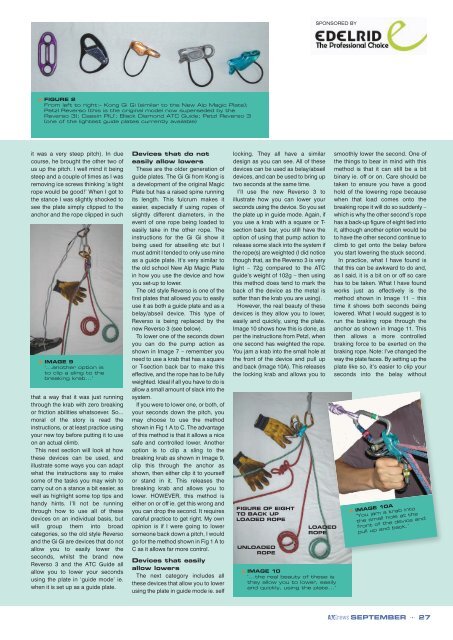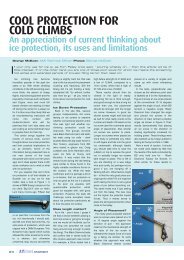WHAT'S SO MAGIC ABOUT MAGIC PLATES? - Glenmore Lodge
WHAT'S SO MAGIC ABOUT MAGIC PLATES? - Glenmore Lodge
WHAT'S SO MAGIC ABOUT MAGIC PLATES? - Glenmore Lodge
Create successful ePaper yourself
Turn your PDF publications into a flip-book with our unique Google optimized e-Paper software.
▲ FIGURE 2<br />
From left to right:– Kong Gi Gi (similar to the New Alp Magic Plate);<br />
Petzl Reverso (this is the original model now superseded by the<br />
Reverso 3); Cassin PIU’; Black Diamond ATC Guide; Petzl Reverso 3<br />
(one of the lightest guide plates currently available)<br />
it was a very steep pitch). In due<br />
course, he brought the other two of<br />
us up the pitch. I well mind it being<br />
steep and a couple of times as I was<br />
removing ice screws thinking ‘a tight<br />
rope would be good!’ When I got to<br />
the stance I was slightly shocked to<br />
see the plate simply clipped to the<br />
anchor and the rope clipped in such<br />
▲ IMAGE 9<br />
‘...another option is<br />
to clip a sling to the<br />
breaking krab...’<br />
that a way that it was just running<br />
through the krab with zero breaking<br />
or friction abilities whatsoever. So...<br />
moral of the story is read the<br />
instructions, or at least practice using<br />
your new toy before putting it to use<br />
on an actual climb.<br />
This next section will look at how<br />
these devices can be used, and<br />
illustrate some ways you can adapt<br />
what the instructions say to make<br />
some of the tasks you may wish to<br />
carry out on a stance a bit easier, as<br />
well as highlight some top tips and<br />
handy hints. I’ll not be running<br />
through how to use all of these<br />
devices on an individual basis, but<br />
will group them into broad<br />
categories, so the old style Reverso<br />
and the Gi Gi are devices that do not<br />
allow you to easily lower the<br />
seconds, whilst the brand new<br />
Reverso 3 and the ATC Guide all<br />
allow you to lower your seconds<br />
using the plate in ‘guide mode’ ie.<br />
when it is set up as a guide plate.<br />
Devices that do not<br />
easily allow lowers<br />
These are the older generation of<br />
guide plates. The Gi Gi from Kong is<br />
a development of the original Magic<br />
Plate but has a raised spine running<br />
its length. This fulcrum makes it<br />
easier, especially if using ropes of<br />
slightly different diameters, in the<br />
event of one rope being loaded to<br />
easily take in the other rope. The<br />
instructions for the Gi Gi show it<br />
being used for abseiling etc but I<br />
must admit I tended to only use mine<br />
as a guide plate. It’s very similar to<br />
the old school New Alp Magic Plate<br />
in how you use the device and how<br />
you set-up to lower.<br />
The old style Reverso is one of the<br />
first plates that allowed you to easily<br />
use it as both a guide plate and as a<br />
belay/abseil device. This type of<br />
Reverso is being replaced by the<br />
new Reverso 3 (see below).<br />
To lower one of the seconds down<br />
you can do the pump action as<br />
shown in Image 7 – remember you<br />
need to use a krab that has a square<br />
or T-section back bar to make this<br />
effective, and the rope has to be fully<br />
weighted. Ideal if all you have to do is<br />
allow a small amount of slack into the<br />
system.<br />
If you were to lower one, or both, of<br />
your seconds down the pitch, you<br />
may choose to use the method<br />
shown in Fig 1 A to C. The advantage<br />
of this method is that it allows a nice<br />
safe and controlled lower. Another<br />
option is to clip a sling to the<br />
breaking krab as shown in Image 9,<br />
clip this through the anchor as<br />
shown, then either clip it to yourself<br />
or stand in it. This releases the<br />
breaking krab and allows you to<br />
lower. HOWEVER, this method is<br />
either on or off ie. get this wrong and<br />
you can drop the second. It requires<br />
careful practice to get right. My own<br />
opinion is if I were going to lower<br />
someone back down a pitch, I would<br />
go for the method shown in Fig 1 A to<br />
C as it allows far more control.<br />
Devices that easily<br />
allow lowers<br />
The next category includes all<br />
these devices that allow you to lower<br />
using the plate in guide mode ie. self<br />
locking. They all have a similar<br />
design as you can see. All of these<br />
devices can be used as belay/abseil<br />
devices, and can be used to bring up<br />
two seconds at the same time.<br />
I’ll use the new Reverso 3 to<br />
illustrate how you can lower your<br />
seconds using the device. So you set<br />
the plate up in guide mode. Again, if<br />
you use a krab with a square or Tsection<br />
back bar, you still have the<br />
option of using that pump action to<br />
release some slack into the system if<br />
the rope(s) are weighted (I did notice<br />
though that, as the Reverso 3 is very<br />
light – 72g compared to the ATC<br />
guide’s weight of 102g – then using<br />
this method does tend to mark the<br />
back of the device as the metal is<br />
softer than the krab you are using).<br />
However, the real beauty of these<br />
devices is they allow you to lower,<br />
easily and quickly, using the plate.<br />
Image 10 shows how this is done, as<br />
per the instructions from Petzl, when<br />
one second has weighted the rope.<br />
You jam a krab into the small hole at<br />
the front of the device and pull up<br />
and back (Image 10A). This releases<br />
the locking krab and allows you to<br />
FIGURE OF EIGHT<br />
TO BACK UP<br />
LOADED ROPE<br />
UNLOADED<br />
ROPE<br />
SPON<strong>SO</strong>RED BY<br />
LOADED<br />
ROPE<br />
▲ IMAGE 10<br />
‘...the real beauty of these is<br />
they allow you to lower, easily<br />
and quickly, using the plate...’<br />
smoothly lower the second. One of<br />
the things to bear in mind with this<br />
method is that it can still be a bit<br />
binary ie. off or on. Care should be<br />
taken to ensure you have a good<br />
hold of the lowering rope because<br />
when that load comes onto the<br />
breaking rope it will do so suddenly –<br />
which is why the other second’s rope<br />
has a back-up figure of eight tied into<br />
it, although another option would be<br />
to have the other second continue to<br />
climb to get onto the belay before<br />
you start lowering the stuck second.<br />
In practice, what I have found is<br />
that this can be awkward to do and,<br />
as I said, it is a bit on or off so care<br />
has to be taken. What I have found<br />
works just as effectively is the<br />
method shown in Image 11 – this<br />
time it shows both seconds being<br />
lowered. What I would suggest is to<br />
run the braking rope through the<br />
anchor as shown in Image 11. This<br />
then allows a more controlled<br />
braking force to be exerted on the<br />
braking rope. Note: I’ve changed the<br />
way the plate faces. By setting up the<br />
plate like so, it’s easier to clip your<br />
seconds into the belay without<br />
▲ IMAGE 10A<br />
‘You jam a krab into<br />
the small hole at the<br />
front of the device and<br />
pull up and back.’<br />
AMInews SEPTEMBER ... 27



